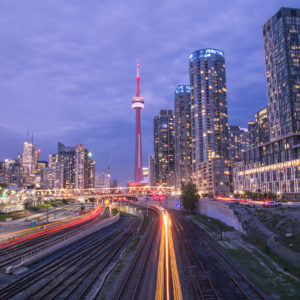North America is increasingly a continent of major cities, with young people, immigrant families and technologically savvy workers flocking to them. You see that from Denver to Vancouver to Monterrey, but Toronto is arguably the North American city that people should pay attention to when considering what makes for a dynamic urban center.
Toronto shows that creating a great city doesn’t always take strong formal leadership. People have the power to shape their communities.
Known as “the city of neighborhoods,” Toronto is an eclectic mix of buildings, people and cultures. It rarely makes headlines for extravagant, city-scale projects or great world-class architecture. Unlike other global cities, Toronto does not have a powerful mayor wielding a big budget. Instead, Toronto’s vibrancy has grown out of the initiatives of individuals, institutions and advocacy groups, passionately working to realize the potential of their communities.
This tradition of civic engagement owes much to the legacy of Jane Jacobs, the revered journalist and urban activist who moved to Toronto from New York City in 1968. Not long after arriving, Jacobs led a mass demonstration that halted construction of the Spadina Expressway, a proposed north-south freeway that would have torn through the center of Toronto’s long-established downtown neighborhoods and parks.
She also played an influential role in the highly celebrated St. Lawrence urban renewal project: a mixed-use residential development built on derelict lands near the city’s waterfront. The project’s affordably priced, low-rise housing and small, accessible parks were considered so successful that it became the prototype for many other urban regeneration projects across North America.
Jacobs demystified urban economics and city planning in a way that empowered people to take ownership of their city. The same can also be said for David Pecaut, a successful businessman from Boston, who became a dedicated and well-loved civic leader in Toronto.
Days before his death in 2009, Pecaut wrote an open letter that described his experience of moving to Toronto. He said he was struck by the unique openness to diverse cultures and “how many people from all walks of life were passionately concerned with making it a great city.”
This experience inspired Pecaut to found the Toronto City Summit Alliance. The alliance of civic leaders came together to decrease poverty, and improve the city’s socio-economic wellbeing.
Now called the Greater Toronto Civic Action Alliance, the group’s impact has been far-reaching. Their achievements include training courses to counter youth unemployment, fellowships to encourage diversity in civic leadership, and campaigns to identify new and viable sources of funding for public transit. Under Pecaut, the organization also championed the creation of the Luminato Festival — a highly regarded annual celebration of the arts in Toronto. Many of the city’s most remarkable and enduring public events are like Luminato. They are the result of volunteer-run, independent initiatives.
Perhaps Toronto’s most surprising rising star is Ryerson University. Ryerson, originally a humble technical college, has rapidly evolved to become a leading institution of innovation, technology and entrepreneurship. Instead of pursuing a traditional form of academia favored by the established universities in the country, Ryerson has leap-frogged ahead to keep pace with the digital age. It provides an applied, career-focused education for a culturally diverse body of students.
Based in the heart of the city, Ryerson’s growing campus attracts large numbers of recent immigrants. Many commute from the far reaches of Toronto’s suburbs. Just last year, Ryerson opened the Ryerson University Student Learning Centre — a much-needed space for hundreds of commuter students to study, relax and pass time between classes.
To be sure, mature cities need big civic projects and functional governments. New York has not been shy about big projects, including the rebuilding of Ground Zero. And cities like Dallas and Houston have benefited from major real estate projects that are redefining the city’s core.
In Toronto’s case, enhanced public services, an improved transit system, and a publicly accessible waterfront would help secure the city’s continued vitality. And a stabilizing of the city’s government after the turbulent years of the late Rob Ford would help the city build and manage such major projects.
Yet, as Toronto continues to develop and redefine itself as a global centre, the challenge will be to retain its strength as a city shaped by the ingenuity of its citizens.
“It is this capacity of social mobilization that can be Toronto’s greatest gift to the world,” Pecaut once said. “We should stop worrying about global rankings and focus on what will make us truly special — which is that we can be the best in the world at collective leadership.”
This also is Toronto’s greatest gift to North America. Local initiative, or collective leadership, can redirect a city and make it come alive. In Toronto’s case, they made it a tapestry of neighborhoods.

